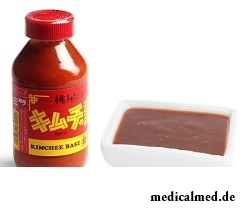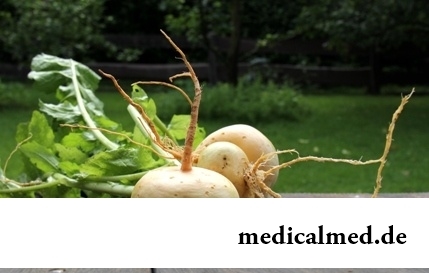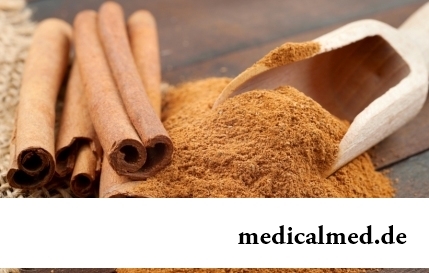





Kimchi
Kimchi is called one of the most popular dishes of Korean cuisine. It represents sharply seasoned fermented vegetables.
In Korea any meal does not do without kimchi. In the country there is the hugest industry of this product, the museums are created, festivals of kimchi are held and the real cult of this national dish reigns. In the Seoul Museum of kimchi the collection from 187 types of this product is presented. At Chondzhu's university there is the only faculty in the world on training of technology of preparation of this snack.
The exact time of emergence of this acute snack is unknown. The first references of a pickles close to kimchi of our times and come to Korea from China, belong to the thirteenth century. Burning red pepper was for the first time delivered to Korea by Portuguese after the sixteenth century.
Now red pepper is one of the most important components of the majority of types of kimchi. The first mentioning of preparation of kimchi with use of red pepper is found in the cookbook published in 1765. The found recipes of preparation of kimchi practically do not differ from recipes of the present. In the twentieth century began to add the components changing its color and taste that led to creation of a large number of kinds of kimchi to this dish.
Preparation of kimchi
Kimchi most often prepares from a garden radish, the Beijing cabbage, a kohlrabi, and also eggplants, cucumbers and other vegetables. Vegetables season with onions juice, red pepper, ginger and garlic. Some culinary specialists add to a dish pine nuts, chestnuts, sesame seeds, algas, pears and even oysters, salty shrimps and octopuses.
In kitchen to bark-saram the technology of preparation of kimchi considerably departed from traditional. It is connected with high cost or absence in places of their accommodation of necessary products. Therefore kimchi to bark-saram is made of carrots, vegetable marrows, a white cabbage. Altered by kimchi to bark-saram entered a diet of residents of the CIS countries in the form of the Korean salads.
Product grades considerably differ depending on the components used at preparation of kimchi, season and the geographical region. In northern regions usually add less red pepper and salts to this product. Also in production use seafood much less often. In the southern regions, for example in Kyonsando or Chollado, burning pepper, salt and such spices as seu-chot (marinated shrimps), melchkh of couples (marinated anchovies), crush экчот (sauce from anchovies) use in large numbers. Not all grades of kimchi acute. White kimchi prepare from the Beijing cabbage or a radish without addition of burning red pepper. These grades are prepared and given to a table in a special brine. White kimchi it is especially popular in the summer.
Nutrition value of kimchi
Hundred grams of this product contain 88,4 g of water, 2 g of proteins, 0,6 g of fats and 1,3 g of carbohydrates and 1,2 g of cellulose. Kimchi also contains phosphorus (28 mg), calcium (45 mg), and also B1 vitamins (0,03 mg), B2 (0,06 mg), vitamin C (21 mg) and niacin (2,1 mg).
Kimchi treats low-calorie food. Hundred grams of a dish contain only 32 kcal.
Influence of kimchi on health
According to the Health magazine of kimchi – one of the healthiest products in the world. This snack contains a significant amount of lactobacilli. Bacteria of this product interfere with excessive fermentation and keep growth of causative organisms in intestines. Besides, it is considered that kimchi – an effective remedy against a hangover and powerful antioxidant. The dish protects walls of vessels from atherosclerosis, reducing concentration of cholesterol in a blood plasma. Residents of Korea consider that the regular use of this product promotes a gradual rassasyvaniye of fatty deposits.
According to the Seoul national university, the hens infected with a virus of bird flu recovered after the use of food with the same bacteria that were found also in this product. The staff of the Korean institute of food researches confirmed increase in immunity at hens to a virus of atypical pneumonia as a result of the use of lactic enzymes of kimchi by them.
In South Korea the incidence of a carcinoma of the stomach is rather high that often is explained by a large number of salty and spicy food. The reason is that enzymatic vegetables contain the chemical radicals increasing probability of developing of oncological diseases.
Sauce of kimchi
Now marinade for a fermentation of the Beijing cabbage is used as separate seasoning. This sauce pickle ingredients for fish and meat dishes. Sauce of kimchi gives to any dish saturated aroma and acute taste. The huge number of the active natural components and vitamins strengthening immunity of an organism and normalizing digestion is its part.
The weight of a human brain makes about 2% of all body weight, however it consumes about 20% of the oxygen coming to blood. This fact does a human brain extremely susceptible to the damages caused by shortage of oxygen.

Cystitis, or inflammation of a mucous membrane of a bladder, this very widespread disease, which, owing to some persons...
Section: Articles about health
What is in our understanding weeds? It plants which are considered to be suitable only for compost pits and feeding of animals. Meanwhile, among the weeds growing literally under legs it is possible to find the mass of the officinal herbs possessing invaluable Paul...
Section: Articles about health
When overcomes feeling of hunger, and an opportunity to have dinner fully is absent, having a snack − the meals, small on volume, stabilizing sugar level in blood comes to the rescue. The relation of nutritionists to having a snack more often negative, but only because as snack people choose the most caloric products with the increased amount of "bystry" carbohydrates: cookies, rolls, chips, candies. Nevertheless, the advantage of having a snack is obvious to weight loss: the person avoids strong feeling of hunger...
Section: Articles about health
The climax, or menopause is the normal process of the termination of genital function of the woman which is followed serious hormonal...
Section: Articles about health
Turnip, radish, horse-radish – once these and other products enjoyed wide popularity at our ancestors, being not only the food sating an organism but also the medicines curing of many diseases. Unfortunately, having given the use of some of them...
Section: Articles about health
For anybody not a secret that our country is one of the most "drinking" in the world. At clear understanding that the use of hard alcoholic drinks – occupation extremely harmful, most of Russians belong to alcoholism with unjustified loyalty. Apparently, existence of a set of myths in which tendency to excessive libations looks nearly positively is explained by it. It is worth getting acquainted with the most widespread of similar delusions and to be convinced in them not...
Section: Articles about health
The varicosity has familiarly many, statistically, this disease more than a half of all adult population. As...
Section: Articles about health
Statistically, in Russia about 34% of citizens smoke. Most of consumers of tobacco has problems with health sooner or later. Not only smokers, but also their relatives suffer. Besides, cigarettes are expensive, and need of their acquisition heavy bry...
Section: Articles about health
Sugar - the digestible refined product which is not of special value for an organism of the modern person. The use of sugar in food is based rather on the psychological dependence caused by desire to indulge itself with something tasty, and further and the biological, caused need of an organism for glucose as a result of big emissions of insulin in blood. Such circulation of insulin and glucose with continuous increase in portions of sugar is rather offensive and can become the reason for a narusha...
Section: Articles about health
The way of life of people promptly changes from year to year: if about ten years ago the personal computer was not in each family...
Section: Articles about health
Neurosis is called pathology of a nervous system at which deviations in functioning of the highest nervous processes are observed. Most often - owing to yet not strengthened mentality - children are subject to neurosises. Premises to emergence of such disturbances can become нез...
Section: Articles about health
Bees – really unique beings. Practically all products of their life activity are used by the person. Since the most ancient times medicinal properties of honey and other substances received in the course of beekeeping are known. The fact that all these products are recognized not only national, but also official medicine is especially significant. About influence and routes of administration of bee "drugs" the speech in this article will also go....
Section: Articles about health
Popular joke that there are no healthy people, and is nedoobsledovanny, most of us considers an honest truth, continually it is necessary to hear that all of us are sick hardly from a school bench. It is hard to say whether so it actually because too often people are treated for nonexistent diseases, and sometimes call a disease what is something another. Sometimes in it the doctors of old school making diagnoses which are cancelled long ago – medicine still unless are guilty...
Section: Articles about health
Feeding by a breast - the integral part of ideal motherhood allowing to come into contact with the kid and to create since early years...
Section: Articles about health
Eyes – one of the most vulnerable areas on a face therefore age changes concern them first of all. Whether it is possible to keep look youth for many years and what procedures are offered for achievement of this purpose by cosmetologists? And maybe, only thing of a vari...
Section: Articles about health
The drugs stopping or oppressing life activity of pathogenic microorganisms are widely applied in clinical practice from 40th years of the last century. Originally antibiotics were called only substances natural (animal, vegetable or microbic) origins, but over time this concept extended, and it includes also semi-synthetic and completely artificial antibacterial drugs....
Section: Articles about health
Producers of milk mixes for children assure: mixes are ideally balanced and adapted for needs of babies. In a sluch...
Section: Articles about health
The next flu epidemic leads to the next panic, from year to year we give in on these manipulations: professionally alarming voice of the announcer in news, reports with calculation of the died patients, an interview with people in white dressing gowns and advertizing of anti-influenza means ра...
Section: Articles about health
There is an opinion that at low temperatures safety of products is ensured longer and better thanks to what the refrigerator is considered the most suitable place for storage of food. In most cases it is fair, however there is a number of products for which low temperatures – the main reason of their premature damage. Storage in the refrigerator leads to their bystry rotting, emergence of a mold, is followed by loss of vitamins and tastes. What products it is better to remove...
Section: Articles about health
Reactive pancreatitis - the disease which is characterized by inflammatory process in a pancreas which arises more often everything...
Section: Articles about health
All got used long ago that, having addressed the plastic surgeon, it is possible to modify natural parameters of a figure or to minimize the damages put to appearance with ruthless time. Many people (preferential women) worldwide е...
Section: Articles about health
Cellulitis - very widespread cosmetic shortcoming which arises approximately at 80% of women sooner or later. Emergence it is connected with change of structure of a hypodermic fatty layer. At the same time on the surface of skin at first there are roughnesses (cambers and cavities), and then small consolidations, the so-called effect of an orange-peel is shown. Changes in a condition of hypodermic cellulose are a consequence of a hormonal imbalance in an organism....
Section: Articles about health
For anybody not a secret that the modern person eats not as his ancestors. For the last 100 years in broad access appeared with...
Section: Articles about health
Sooner or later hair turn gray at all. Many people try to hide these changes, returning natural color of the hair by means of coloring, or considerably changing it for the purpose of creation of absolutely new image. All know that the gray hair is a sign приближающ...
Section: Articles about health
Ayurveda - the most ancient tselitelsky practice which came to us from India. It represents the doctrine about maintenance of physical, psychological and moral health of the person by means of the complex of procedures including a diet, cleaning of an organism, breathing exercises, massage, and in case of a disease - and medicinal therapy. The healers practicing Ayurveda assign very important part to spices, and at the heart of Ayurvedic drugs, as a rule, there are they. It is considered that spices not of t...
Section: Articles about health


